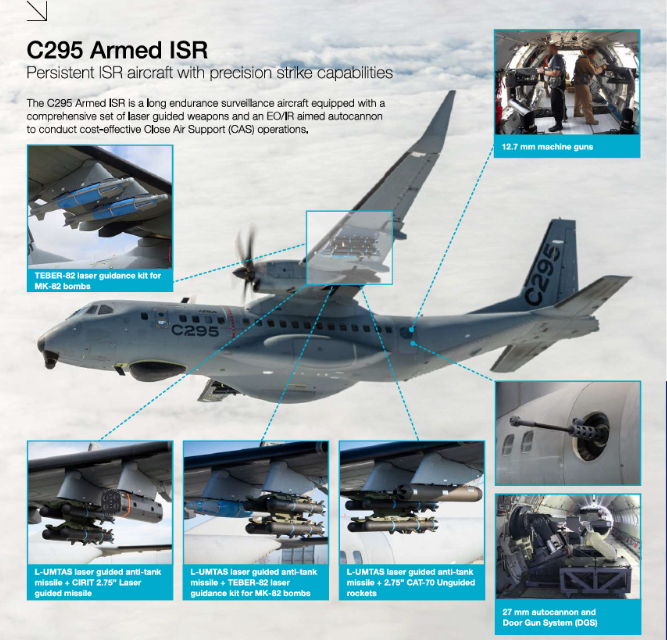Manufacturing ecosystem for Airbus C-295 aircraft taking shape in India
Context:
The first C-295 transport aircraft will be delivered to the Indian Air Force (IAF) in September; in preparation, Airbus has trained six pilots in Seville, and 20-person maintenance staff is presently undergoing training.
What is the speciality of Airbus C-295 Aircraft?
- Origins and Development:
- CASA (Construcciones Aeronáuticas SA), a Spanish aerospace manufacturer, started design work on the C295 in the 1990s as a derivative of the CASA/IPTN CN-235 cargo aircraft.
- On November 28, 1997, the C-295 prototype took flight for the first time.
- A few times after the successful maiden flight, quantity production started.
- Launch Operational and Customer Services:
- The Spanish Air Force placed the initial order for nine C-295s in April 1999, becoming the model’s launch client.
- The C-295 was made operational with the Spanish Air Force in 2001, demonstrating its suitability for duty.
- The C-295 was then swiftly ordered by other nations, demonstrating the growing demand for it on the global market.
- Designation Change:
- In the year 2000, CASA was integrated into the European Aeronautic Defence and Space Company (EADS).
- Consequently, the aircraft’s name was changed to EADS CASA C-295, reflecting its association with the larger multinational group.
- Manufacturing and Assembly:
- Manufacturing and final assembly of the C-295 primarily take place at Airbus Defence and Space facilities in San Pablo Airport, Seville, Spain.
- To meet the demand from other regions, manufacturing agreements have been made with some customers.
- Notably, Indonesian Aerospace began producing the CN-295 under license at its Bandung, Indonesia facilities through a collaboration with Airbus Defence & Space in 2011.
- Flexibility and aptitudes:
- The C-295 is a flexible aircraft that can successfully carry out a variety of tasks.
- Tactical transport, cargo dropping, parachute operations, electronic signals intelligence (ELINT), medical evacuation (MEDEVAC), and marine patrol are just a few of the missions it can be customized for.
- Pallets can be used to attach specialized equipment, making it simple to install and remove as needed for operational purposes.
- Civil Version and Commercial Pursuit:
- Even though the C-295 was primarily targeted at the military and government markets, efforts to create a commercial variant were not aggressively explored until much later.
- The C-295 entered the commercial aviation market in 2017 with the signing of the first contract for one.
- Worldwide Presence:
- Several countries, including Spain, Egypt, Poland, Canada, Brazil, Mexico, Portugal, and others have purchased the C-295.
- It has supported operations around the world in places like the former Yugoslavia, Afghanistan, Iraq, Lebanon, and Chad.
How is India going to insert these planes into Indian Air Force?
- Acquisition Agreement:
- In September 2021, the Indian Air Force (IAF) and Airbus and Space S.A., Spain, agreed to a 22,000 crore agreement for the purchase of 56 C-295MW cargo planes.
- The IAF will use this procurement to replace the current Avro aircraft currently in service.
- Training Regimn:
- Six pilots were trained by Airbus in Seville before the first C-295 aircraft was delivered.
- A 20-person maintenance staff is also now receiving training to assist in the upkeep and operation of the new aircraft. Ground-breaking ceremonies for a training centre were performed in March at the Air Force Station in Agra.
- By the end of 2024, a full-motion simulator that will be included in the training centre is anticipated to be delivered.
- Pilots and crew members can practice in realistic training situations thanks to the simulator.
- Final Assembly Line (FAL):
- In collaboration with Tata Advanced Systems Limited (TASL), Airbus is establishing a Final Assembly Line (FAL) in Vadodara.
- By the middle of 2024, the FAL is anticipated to be ready, and by November 2024, manufacturing will start.
- The manufacturing of the final 40 aircraft in India will take place here.
- Indigenous Production:
- Following the deal, 16 aircraft will be produced in the Airbus plant in Seville, Spain.
- Airbus and TASL will work together to produce the final 40 aircraft in India.
- Production Schedule:
- The second C-295 aircraft is expected to be delivered in May 2024, and then seven more at a pace of one per month are expected to be delivered in 2024.
- In September 2026, the nation of India is anticipated to deliver its first aeroplane.
- Obligations:
- Significant “Make-in-India” and offset responsibilities are a part of the arrangement.
- In addition to the “Make in India” standards, Airbus has agreed to meet 30% of its offset obligations.
- This would increase India’s capacity for defence manufacturing because a sizeable amount of the production and related tasks will be done there.
- Localized Systems:
- The indigenous radar warning receiver and missile approach warning systems of the C-295 aircraft will be produced by Bharat Electronics Limited.
- The aircraft will also be equipped with a countermeasure dispensing system produced by Bharat Dynamics Limited.
In conclusion, the purchase of C-295 transport planes represents a significant advancement for the Indian Air Force, with an emphasis on ‘Make-in-India’ programs and homegrown production capabilities. The project is expected to improve the IAF’s operational capabilities and help India’s defence sector expand.





